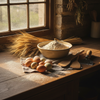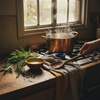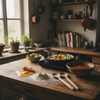Baking Pan Essentials: Choose, Use & Care Tips
Key Takeaways
- Choosing the right baking pan is crucial for successful cooking and baking outcomes.
- Different materials affect heat distribution and can influence the final result of your dish.
- Understanding how your bakeware reacts to heat helps prevent common cooking issues like burnt bottoms.
- Proper selection and use of baking pans can elevate your culinary creations from ordinary to exceptional.
Table of Contents
- Baking Pan Essentials: Choose, Use & Care Tips
- Aluminum vs. Stainless Steel: The Heat Conductivity Battle
- Cast Iron, Glass & Ceramic: When Standard Won't Cut It
- Silicone: The Flexible Game-Changer
- Size Matters: Pan Dimensions and Recipe Success
- Core Materials and Their Benefits
- Cleaning and Maintenance Guides
- Common Conversions and Substitutions
- Tips for Optimal Baking Pan Use
- Comprehensive Material Comparison
- Expert-Recommended Baking Pans
Baking Pan Essentials: Choose, Use & Care Tips
The wrong baking pan can turn your culinary masterpiece into a kitchen disaster faster than you can say "burnt bottom." Whether you're tackling your first soufflé or perfecting that holiday roast, your choice of bakeware determines whether you're plating success or scraping failure off the pan. From heat distribution quirks to material reactivity, every detail matters when you're creating something memorable.
Professional bakers know that aluminum conducts heat 16 times faster than stainless steel, while cast iron retains heat so efficiently it continues cooking even after leaving the oven. Understanding these material differences transforms good home cooks into confident kitchen creators who choose tools as deliberately as they choose ingredients.
For the best results, pairing your favorite baking pan with the right utensils is essential. Consider using a silicone spatula set for effortless mixing and scraping, and a stainless steel measuring cup set to ensure precise ingredient measurements every time.
Aluminum vs. Stainless Steel: The Heat Conductivity Battle

Aluminum baking pans heat up lightning-fast, making them perfect for recipes requiring quick temperature changes. However, this speed comes with a catch, acidic ingredients like tomatoes or citrus can react with uncoated aluminum, creating metallic flavors that'll make your taste buds revolt. The lightweight construction also means these pans warp under extreme heat stress.
Stainless steel takes the opposite approach, heating slowly but evenly. This material won't react with acidic foods, making it ideal for versatile cooking. The trade-off? Longer preheating times and potential hot spots if the pan lacks an aluminum or copper core. Professional kitchens often choose tri-ply stainless steel, stainless exterior with an aluminum core, for the best of both worlds.
Aluminum Advantages:
- Rapid, responsive heating
- Lightweight and affordable
- Excellent for short baking times
Aluminum Drawbacks:
- Reacts with acidic ingredients
- Prone to warping under high heat
- May discolor over time
Cast Iron, Glass & Ceramic: When Standard Won't Cut It
Cast iron transforms any baking pan into a heat-retention powerhouse. Once heated, it maintains temperature so consistently that your cornbread develops that coveted crispy crust while staying tender inside. The weight, often 3-4 times heavier than aluminum, provides stability but demands strong wrists and proper storage planning.
Glass and ceramic offer visual advantages that metal can't match. You can monitor browning progress without opening the oven door, preventing temperature fluctuations that ruin delicate bakes. These materials distribute heat gently and evenly, making them ideal for custards, casseroles, and anything requiring gradual temperature changes. The thermal shock risk means you'll need to avoid extreme temperature changes, no ice water on hot glass.
| Material | Heat Retention | Weight | Visual Monitoring | Best For |
|---|---|---|---|---|
| Cast Iron | Excellent | Heavy | No | Breads, cornbread, dense cakes |
| Glass | Good | Moderate | Yes | Casseroles, fruit crisps |
| Ceramic | Good | Moderate | Yes | Custards, delicate pastries |
Silicone: The Flexible Game-Changer
Silicone baking pans bend the rules, literally. Their flexibility makes food release effortless, eliminating the parchment paper dance and reducing cleanup time. Quality silicone withstands temperatures from freezer to 450°F oven, though some cheaper versions may impart rubbery flavors or fail under high heat.
The material's poor heat conduction means longer baking times and less browning, great for delicate muffins, problematic for crispy-bottomed items. Professional-grade silicone, like the forever-chemical-free options from premium manufacturers, maintains structural integrity and food safety standards that cheaper alternatives can't match.
If you want to learn more about the advantages of using a baking spatula with your silicone bakeware, check out our in-depth guide.
Size Matters: Pan Dimensions and Recipe Success

Substituting a 9-inch round baking pan for an 8-inch changes more than just appearance, it affects baking time, texture, and doneness. The 9-inch pan has 25% more surface area, meaning batters spread thinner and bake faster. Understanding volume equivalencies prevents kitchen disasters. A standard 9x13 inch rectangular pan holds the same volume as two 8-inch round pans, making it perfect for sheet cakes or doubling round cake recipes.
For a complete selection of bakeware and accessories to match any recipe, explore our curated baking collection.
Core Materials and Their Benefits
Each baking pan material brings distinct advantages to your kitchen arsenal. Understanding these differences transforms recipe outcomes from unpredictable to consistently excellent.
Aluminum Baking Pans
Aluminum dominates professional kitchens for good reason, it conducts heat faster than any other common baking pan material. This lightweight champion heats evenly and responds quickly to temperature changes, making it ideal for cookies, muffins, and quick breads that benefit from rapid heat transfer.
However, aluminum's reactive nature means it interacts with acidic ingredients like lemon juice, tomatoes, or vinegar, potentially creating metallic flavors. Anodized aluminum solves this problem by creating a protective surface layer while maintaining aluminum's superior heat conduction properties.
Stainless Steel Pans
Stainless steel offers unmatched durability and chemical neutrality. These pans resist warping, scratching, and corrosion while maintaining their appearance through years of heavy use. The material's non-reactive surface preserves ingredient flavors without interference.
The trade-off comes in heat distribution, stainless steel conducts heat more slowly than aluminum, which can create hot spots. Look for tri-ply construction with an aluminum core sandwiched between stainless steel layers to combine durability with even heating. For best results, use a stainless steel measuring spoon set to ensure accuracy in your recipes.
Cast Iron Pans
Cast iron transforms from oven to table seamlessly, retaining heat longer than any other material. This thermal mass creates perfectly crispy edges on cornbread and maintains consistent temperatures for slow-baking recipes like deep-dish pizza or skillet cookies.
Proper seasoning creates a naturally non-stick surface that improves with use. The weight requires sturdy storage solutions, but the versatility, from stovetop to oven to campfire, makes cast iron indispensable for serious bakers.
Glass and Ceramic Pans
Glass and ceramic provide the most even heat distribution, eliminating hot spots that cause uneven browning. These transparent materials let you monitor browning from all angles, particularly valuable for custards, casseroles, and delicate cakes.
Temperature shock poses the main limitation, rapid changes from hot to cold can cause cracking. Always place hot glass pans on dry towels, never cold surfaces, and avoid extreme temperature transitions.
Silicone Pans
Silicone revolutionizes release convenience with built-in flexibility that pops out even the most intricate shapes. These colorful pans store efficiently by nesting or folding and clean effortlessly in the dishwasher.
Temperature limitations restrict silicone to recipes under 450°F, and the flexible walls can make transferring full pans challenging. Place silicone pans on rigid baking sheets for easier handling and more stable results. For more tips on choosing the right tools, see our article on top rated seamless spatulas for baking.
Cleaning and Maintenance Guides
Proper care extends baking pan lifespan while maintaining optimal performance. Each material demands specific techniques to preserve its cooking properties and appearance.
Non-Stick Pan Care
Non-stick coatings require gentle handling to maintain their release properties. Use soft sponges or cloths with mild dish soap, avoiding abrasive scrubbers that scratch the surface. Wooden or silicone utensils prevent coating damage during use.
Store non-stick pans with protective layers, pan protectors, paper towels, or cloth, between stacked pieces. Replace pans when coatings begin flaking or showing wear patterns, as damaged surfaces affect both performance and food safety. For safe and effective cleaning, a seamless spatula set is ideal for non-stick cookware.
Seasoning Cast Iron Pans
Cast iron seasoning creates a protective, non-stick surface through polymerized oil layers. Start with a completely clean, dry pan, scrub off any rust or old seasoning with steel wool if necessary.
Apply a thin layer of high-smoke-point oil like flaxseed, grapeseed, or vegetable shortening to all surfaces. Wipe away excess oil until the pan appears almost dry, too much oil creates sticky, uneven seasoning. Bake upside-down at 450°F for one hour, then cool completely in the oven. Repeat this process 3-4 times for optimal results.
Stainless Steel Maintenance
Stainless steel tolerates aggressive cleaning without damage. For stuck-on food, create a paste with baking soda and water, let it sit for 15 minutes, then scrub with a non-abrasive sponge. Bar Keeper's Friend removes heat stains and restores original shine.
Avoid chlorine bleach, which can cause pitting, and don't let salty foods sit in stainless steel pans for extended periods. Proper drying prevents water spots that dull the surface finish. For more details on stainless steel care, see this comprehensive baking basics guide.
Common Conversions and Substitutions

Baking pan substitutions require understanding volume relationships and how shape affects baking time. These conversions save recipes when you lack the specified pan size.
| Original Pan | Volume | Substitute Options | Time Adjustment |
|---|---|---|---|
| 8-inch round | 6 cups | 8x8 square, 9x5 loaf | Same time |
| 9-inch round | 8 cups | 8x8 square + 4 cup ramekin, 11x7 rectangle | Check 5-10 min early |
| 9x13 rectangle | 14 cups | Two 9-inch rounds, 15x10 jelly roll | Check 5-10 min early |
| 9x5 loaf | 8 cups | 8-inch round, 8x8 square | Same time |
Tips for Optimal Baking Pan Use
Preheating and Preparation Techniques
Proper preheating transforms amateur bakes into professional results. Always preheat your oven for at least 15 minutes before inserting your baking pan, this ensures even heat distribution from the moment your batter hits the metal. For glass and ceramic pans, skip the preheating step entirely; these materials need gradual temperature changes to prevent thermal shock and cracking.
Preparation extends beyond temperature. Lightly grease aluminum and stainless steel pans with butter or cooking spray, then dust with flour for foolproof release. Parchment paper works universally but becomes essential for delicate items like macarons or thin cookies that might stick despite greasing.
Temperature and Timing Adjustments
Dark-colored pans absorb heat faster than light ones, requiring temperature reductions of 25°F to prevent over-browning. Glass pans retain heat longer, so reduce temperature by 25°F and check for doneness 5-10 minutes earlier than recipe instructions suggest.
Pan depth dramatically affects baking time. A 2-inch deep cake pan needs 15-20 minutes longer than a 1-inch pan for the same batter volume. Test doneness with a toothpick in the center, it should emerge with just a few moist crumbs clinging.
Troubleshooting Common Baking Issues
Warped pans create uneven baking and hot spots. Prevent warping by avoiding extreme temperature shocks, never place a hot pan directly under cold water. If your pan has already warped, place it upside-down on a flat surface and gently press the raised areas back into place while still warm.
Sticking issues often stem from inadequate preparation or worn non-stick coatings. When non-stick surfaces begin flaking or food consistently sticks despite proper greasing, replacement becomes necessary for both performance and food safety. For more on handling delicate bakes, see our guide to the flexible cookie spatula for baking.
Comprehensive Material Comparison
Heat Distribution Performance
Aluminum leads in rapid, even heat conduction, making it ideal for cookies and pastries requiring quick, uniform browning. However, lightweight aluminum warps easily under high heat, a critical limitation for heavy batters or extended baking times.
Cast iron provides unmatched heat retention, creating perfectly crispy crusts on breads and maintaining consistent temperatures throughout long baking cycles. The trade-off comes in weight and maintenance requirements that intimidate casual bakers.
| Material | Heat Conduction | Durability | Maintenance Level | Best Applications |
|---|---|---|---|---|
| Aluminum | Excellent | Moderate | Low | Cookies, sheet cakes |
| Stainless Steel | Good | Excellent | Low | Roasting, versatile use |
| Cast Iron | Superior retention | Lifetime | High | Breads, cornbread |
| Glass/Ceramic | Even, gentle | Good | Low | Casseroles, layer cakes |
| Silicone | Poor | Good | Very low | Muffins, flexible shapes |
Durability and Longevity Factors
Stainless steel delivers the longest service life with minimal care, resisting warping, scratching, and chemical reactions. Quality stainless steel pans often outlast their owners, making them excellent long-term investments despite higher upfront costs.
Glass and ceramic pans offer decades of reliable service when handled properly, but their vulnerability to thermal shock means one careless moment can end their usefulness. Store these materials carefully and always allow gradual temperature changes. For a broader overview of bakeware types and their uses, see this bakeware reference.
Expert-Recommended Baking Pans

Best Beginner-Friendly Options
Best for: New bakers seeking reliable, forgiving performance
Non-stick aluminum pans provide the most beginner-friendly experience, offering easy food release and simple cleanup. Nordic Ware's aluminum pans feature reinforced rims that resist warping while maintaining excellent heat conduction for consistent results.
Pyrex glass baking dishes excel for casseroles and brownies, allowing visual monitoring of browning progress. Their clear construction helps new bakers learn proper doneness indicators while providing gentle, even heating that forgives minor timing errors. For even more versatility in your kitchen, try a 5-piece seamless spatula set for all your baking and cooking needs.
Professional-Grade Selections
Best for: Serious bakers demanding restaurant-quality results
Williams Sonoma's Goldtouch pans combine aluminum's heat conduction with ceramic coating durability. The aluminized steel construction prevents warping while the ceramic coating ensures easy release and long-lasting performance. For those who want to bake like the pros, investing in tri-ply stainless steel or heavy-duty cast iron pans will deliver consistent, bakery-quality results for years to come.
For spatulas and utensils trusted by America’s Test Kitchen, Cook’s Illustrated, and Food Network, DI ORO’s Seamless Series spatulas are award-winning and designed for both home chefs and professionals. See the America’s Test Kitchen Equipment Review and Food Network’s Best Spoonula for more details.
Frequently Asked Questions
How do different baking pan materials affect heat distribution and cooking results?
Baking pan materials influence how heat spreads and retains, directly impacting your dish’s texture and doneness. For example, aluminum heats quickly and evenly for crisp edges, while cast iron holds heat longer, continuing to cook food after removal from the oven. Understanding these traits helps prevent issues like burnt bottoms or uneven baking.
What are the pros and cons of using aluminum versus stainless steel baking pans?
Aluminum pans heat up fast and distribute heat evenly, making them ideal for recipes needing quick temperature changes, but they can react with acidic foods and warp under high heat. Stainless steel heats more slowly and may have hot spots without a core, but it’s non-reactive and durable, offering versatility for a wide range of dishes.
When should I choose cast iron, glass, or ceramic bakeware over standard metal pans?
Choose cast iron when you want excellent heat retention for dishes that benefit from steady cooking, like roasts or deep-dish casseroles. Glass and ceramic are great for even, gentle heating and are perfect for baked goods like casseroles or desserts where you want to monitor browning and avoid metallic reactions.
What are the best practices for caring for and maintaining various types of baking pans?
To extend your baking pans’ lifespan, avoid thermal shock by letting them cool before washing, hand wash when possible to preserve coatings, and use proper greasing to prevent sticking. Aluminum pans benefit from gentle cleaning to avoid discoloration, while cast iron requires seasoning to maintain its non-stick surface and prevent rust.




